

Personality Quiz. Animal Spirit Guides Shamanism Working With Animal Spirits. Animal Spirit Guides Shamanism Working With Animal Spirits. Animal Spirit Guides Shamanism Working With Animal Spirits. Animal Spirit Guides Shamanism Working With Animal Spirits. Animal Spirit Guides Shamanism Working With Animal Spirits. Animal Spirit Guides Shamanism Working With Animal Spirits. Mayan Oracle - Calendars Date Viewer, Dreamspell Audio. Printing InstructionsThese instructions are for a desktop printer which prints on the back of the paper as to when fed into the printer.
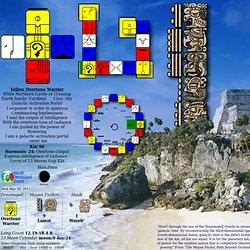
You may have to manually re-order each paper sheet order before printing the backs depending on your printer. Download the image archive and the Daykeeper rtf file above.
Idealist temperament. Description[edit] Idealists are abstract in speech and cooperative in pursuing their goals.
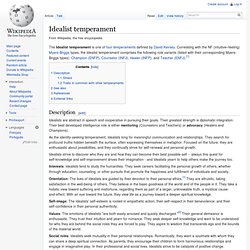
Their greatest strength is diplomatic integration. Their best developed intelligence role is either mentoring (Counselors and Teachers) or advocacy (Healers and Champions). As the identity-seeking temperament, Idealists long for meaningful communication and relationships. They search for profound truths hidden beneath the surface, often expressing themselves in metaphor. Temperament Website - Portrait of the Idealist® (NF) Idealists (NFs), as a temperament, are passionately concerned with personal growth and development.

Idealists strive to discover who they are and how they can become their best possible self -- always this quest for self-knowledge and self-improvement drives their imagination.
Meyer Briggs. Portrait of an INFP. As an INFP, your primary mode of living is focused internally, where you deal with things according to how you feel about them, or how they fit into your personal value system.

Your secondary mode is external, where you take things in primarily via your intuition. INFPs, more than other iNtuitive Feeling types, are focused on making the world a better place for people. INFP Relationships. INFPs present a calm, pleasant face to the world.
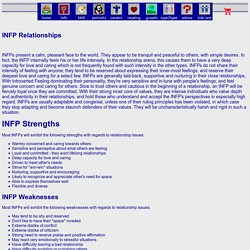
They appear to be tranquil and peaceful to others, with simple desires. In fact, the INFP internally feels his or her life intensely. In the relationship arena, this causes them to have a very deep capacity for love and caring which is not frequently found with such intensity in the other types. INFPs do not share their intensity of feeling with anyone; they tend to be reserved about expressing their inner-most feelings, and reserve their deepest love and caring for a select few.
Extroversion and introversion. The trait of extraversion–introversion is a central dimension of human personality theories.
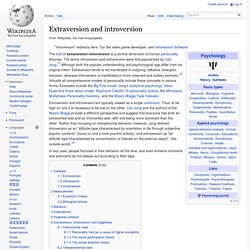
The terms introversion and extraversion were first popularized by Carl Jung,[1] Although both the popular understanding and psychological age differ from his original intent. Extraversion tends to be manifested in outgoing, talkative, energetic behavior, whereas introversion is manifested in more reserved and solitary behavior.[2] Virtually all comprehensive models of personality include these concepts in various forms. Examples include the Big Five model, Jung's analytical psychology, Hans Eysenck's three-factor model, Raymond Cattell's 16 personality factors, the Minnesota Multiphasic Personality Inventory, and the Myers–Briggs Type Indicator. Myers-Briggs Type Indicator. A chart with descriptions of each Myers–Briggs personality type and the four dichotomies central to the theory.
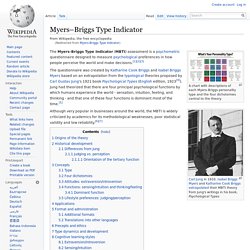
The Myers–Briggs Type Indicator (MBTI) assessment is a psychometric questionnaire designed to measure psychological preferences in how people perceive the world and make decisions.[1][2][3] The questionnaire was created by Katharine Cook Briggs and Isabel Briggs Myers based on an extrapolation from the typological theories proposed by Carl Gustav Jung's 1921 book Psychological Types (English edition, 1923[4]). Jung had theorized that there are four principal psychological functions by which humans experience the world - sensation, intuition, feeling, and thinking - and that one of these four functions is dominant most of the time.[5] Although very popular in businesses around the world, the MBTI is widely criticized by academics for its methodological weaknesses, poor statistical validity and low reliability.[6][7] Feeling. Feeling is the nominalization of the verb to feel.
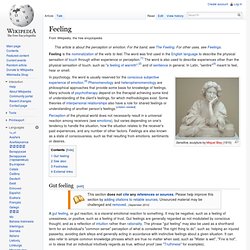
The word was first used in the English language to describe the physical sensation of touch through either experience or perception.[1] The word is also used to describe experiences other than the physical sensation of touch, such as "a feeling of warmth".[2] and of sentience in general. In Latin, "sentire"[3] meant to feel, hear or smell. Perception of the physical world does not necessarily result in a universal reaction among receivers (see emotions), but varies depending on one's tendency to handle the situation, how the situation relates to the receiver's past experiences, and any number of other factors. Feelings are also known as a state of consciousness, such as that resulting from emotions, sentiments or desires. Gut feeling[edit] See also[edit] [edit] External links[edit] Perception. Since the rise of experimental psychology in the 19th Century, psychology's understanding of perception has progressed by combining a variety of techniques.[3] Psychophysics quantitatively describes the relationships between the physical qualities of the sensory input and perception.[5] Sensory neuroscience studies the brain mechanisms underlying perception.

Perceptual systems can also be studied computationally, in terms of the information they process. Perceptual issues in philosophy include the extent to which sensory qualities such as sound, smell or color exist in objective reality rather than in the mind of the perceiver.[3] INFP Profile. Introverted iNtuitive Feeling Perceiving by Joe Butt Profile: INFP Revision: 3.0 Date of Revision: 26 Feb 2005 "I remember the first albatross I ever saw. ...

The Healer- 3.6.2.6.5.4.4.3.3. Type Two in Brief Twos are empathetic, sincere, and warm-hearted. They are friendly, generous, and self-sacrificing, but can also be sentimental, flattering, and people-pleasing. They are well-meaning and driven to be close to others, but can slip into doing things for others in order to be needed.